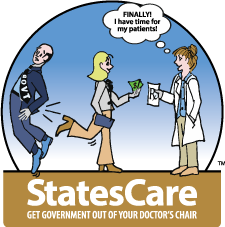
Can Healthcare Success be Health Care Disaster?
Published on HuffingtonPost.com, September 1, 2014
How can success also be disaster, especially in healthcare? As the Michael W. Smith song says, “Let me show you the way.”
Remember that healthcare one word means a system, one that currently accounts for 20% of US national spending. Health care — two words — refers to a personal service relationship between a patient and a provider.
ACA success
The second reason (the first is given later) that president Obama gave in 2008-10 to justify his healthcare reform was the need to increase the number of insured Americans. The third reason was to raise insurance from a “substandard” level to “what all Americans deserve,” meaning to expand benefits. Recent reports suggest that ACA is a success on both counts. The White House defines healthcare success as increasing the number of ACA-insured Americans. Based on that definition, Medicaid expansion — a part of the ACA Law — is a triumph.
In California, MediCal (their Medicaid program) recently reported 2.2 million new enrollees since January 1, 2014. This brings the total of Californians receiving “free” [paid by others] health insurance to 30% of the entire state, with its population of 38 million.
New Mexico projected that Medicaid expansion would sign up 219,000 new enrollees over a six-year period. In the first year alone (2014), they have already signed up 155,000, 71% of the best-case six-year estimate. For New Mexico, 35% of the State’s population is now receiving “free” (Medicaid) health insurance.
Medicaid expansion should be listed in the ACA ‘win’ column since it increased insurance coverage.
Success in the private insurance market is less clear. Reputedly more than six million Americans signed up through healthcare.gov for ACA-supported insurance. There is however doubt about whether they all actually have insurance, given the technical glitches in the federal website. Therefore, it is uncertain whether the ACA signups compensate for the at least seven million Americans who lost their insurance because of ACA.
On balance, we can call ACA signups a success.
Expanded Benefits
All health insurance for sale after January 2014 by the ACA law had to offer the Eight Essential Benefits package. Denial for pre-existing condition became federally illegal. Thus, Americans have more health benefits covered now than before ACA — a second indicator of success.
Whether we need or even want these expanded benefits, by law we must pay for them and are penalized if we do not. I am 71 years old and my wife is 67. Under ACA, I am required by law to purchase insurance that offers “free” contraceptives and full maternity benefits.
Greater Demand
Anyone who took an Economics course knows what happens when you have more ACAinsured people who have expanded benefits. The demand for services and goods goes up because of the “moral hazard.”
The moral hazard explains why some people spend money without any regard to price or value — the money they spend is not their own. “I don’t care what it costs,” cry those who spend OPM (other people’s money). Why should they care? “It ain’t my money!”
Between moral hazard, increased insured individuals and expansion of benefits, not to mention the addition of veterans allowed to seek care in the private sector, the demand for health services and goods will skyrocket. People can now demand whatever care they want, when they want it, and based on Washington’s promises, they (you) expect to get it.
In other words, ACA is a success, so, how is it also a disaster?
Spending Future Dollars
Estimates for the cost of ACA range from 1.76 to 2.7 trillion dollars. The U.S. will spend more just on the ACA than the entire GDP of 188 out of 195 nations on earth! Sadly, no one knows what ACA will ultimately cost. Many fear the price tag will be even higher than several trillion. For instance, the original estimate for creating www.healthcare.gov was $300 million. It is now projected to top $1 billion, simply for a website!
This massive spending is truly ironic because the first reason the President gave for his healthcare reform plan was to reduce spending on healthcare, to “bend down its unsustainable spending curve.”
The first “A” in ACA stands for “affordable.” The Law is clearly not affordable nationally. Is it affordable personally? The answer is a resounding no, in two ways: jobs (non-bureaucratic) and the contents of your wallet.
Large employers such as John Deere, Verizon, and AT&T warned Congress about the constraining effects of ACA on jobs. Congress responded by calling them disloyal. When you are in business and your fixed costs go up (by law) but you cannot raise prices, what do you do? You certainly do not add jobs. In fact, you cut jobs or turn full time employment into part-time. This has happened.
Meanwhile, your wallet is shrinking partly because less is going in, but also because more is being taken out. In addition to more (not less!) expensive health insurance, with an average 41% increase, there are twenty new or higher taxes. This is as ironic as the increased national spending. On October 4, 2008, candidate Barack Obama told supporters, “health care should never be purchased with tax increases on middle class families.”
We are spending more, and at the same time, we are producing fewer dollars. Thus, we must spend more future dollars, i.e., borrow more and add to the deficit.
Spending on What?
First, there is the formulation, writing, actuarial projections, and accounting of over 10,500 pages of rules and regulations in the Federal Register. That is over 10 million words, so imagine how many lawyers we “need” to define, interpret, and argue over them!
Then there is the implementation. Expanding Medicaid is not as easy as simply announcing an elevation of eligibility to 138% of the poverty line. Whole new procedures, forms and rules are involved. Entire new computer systems and authorization processes must be created along with inter- communication lines across multiple agencies. This bureaucratic explosion of administrative machinery and processes had to be duplicated in each state, as Medicaid programs are state-run.
ACA mandated the creation of Health Insurance Exchanges. Since a majority of States chose not to create State-based Exchanges, Washington had to create a federal platform — the infamous healthcare.gov.
Next, there are change (Executive) orders — today’s ACA is very, very different from what was signed into Law on March 23, 2010. As anyone knows who has ever built, well, anything, the change orders jack up the cost tremendously and unnecessarily.
At the same time that ACA spends trillions on bureaucracy, it cuts spending on health care services, viz., Medicare payments to providers are reduced by more than $700 billion. The answer to the question “spending on what?” is this: dollars that go to healthcare bureaucracy are dollars taken from health care service.
Success = Disaster
More people demanding more care services and goods increases spending. Reduced spending on health care makes it less available. Thus, increased demand plus decreased supply creates an unbalanced healthcare system: a medical disaster of unmet needs.
Spending more dollars we don’t have combined with commercial suppression — both driven by ACA “success” — produces a financial disaster for our country, at a time when we are already suffering unremitting recession.
ACA SUCCESS → NATIONAL DISASTER
Why Read This Article:
Obamacare adds millions of Americans to the rolls of the newly insured: this is what the President calls “success.” Meanwhile, Washington pays fewer and fewer doctors to care for them. That is what everyone else calls a disaster.
By Deane Waldman, MD, MBA, author of "The Cancer in the American Healthcare System"
Professor Emeritus of Pediatrics, Pathology and Decision Science, and holds the “Consumer Advocate” position on the Board of Directors of the New Mexico Health Insurance Exchange, and Adjunct Scholar (Healthcare) for the Rio Grande Foundation.
Mailing address:
ADM Consulting & Books
PO Box 37396
Albuquerque, New Mexico 87176-7396
Copyright © 2015-2019 ADM Consulting & Books. All Rights Reserved. All other trademarks on this site are the property of their respective owners. Site design and maintenance by www.DesignStrategies.com.



